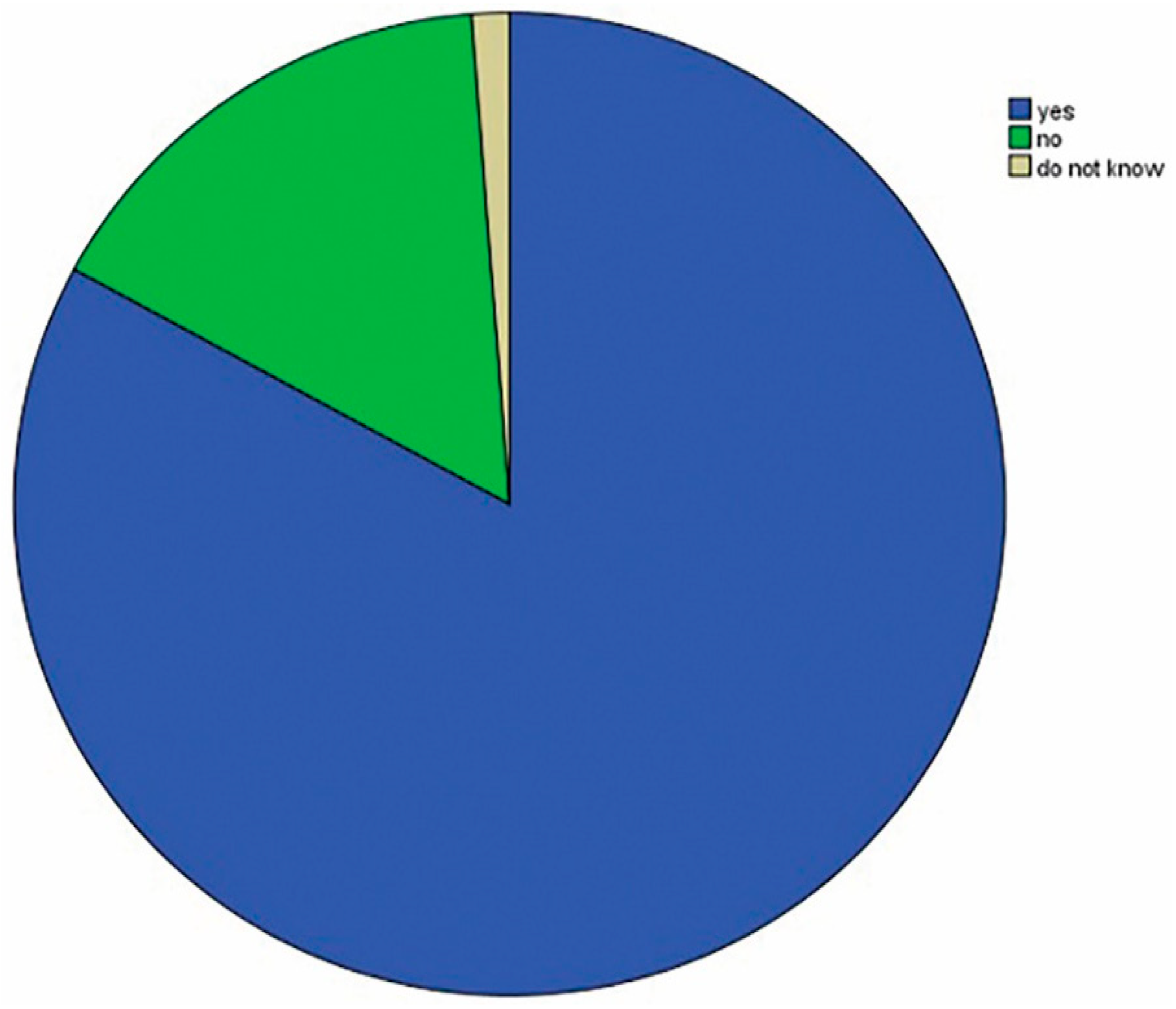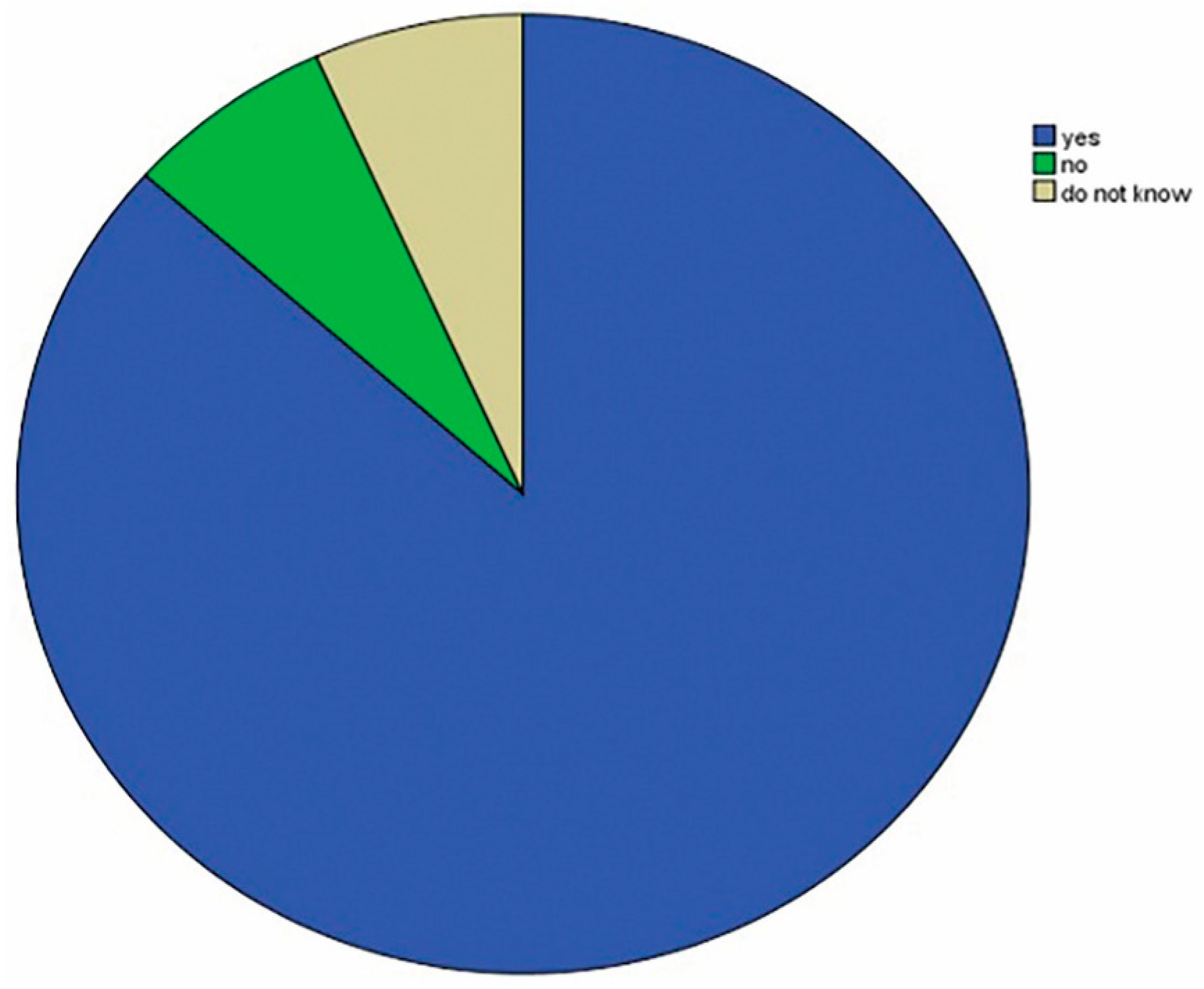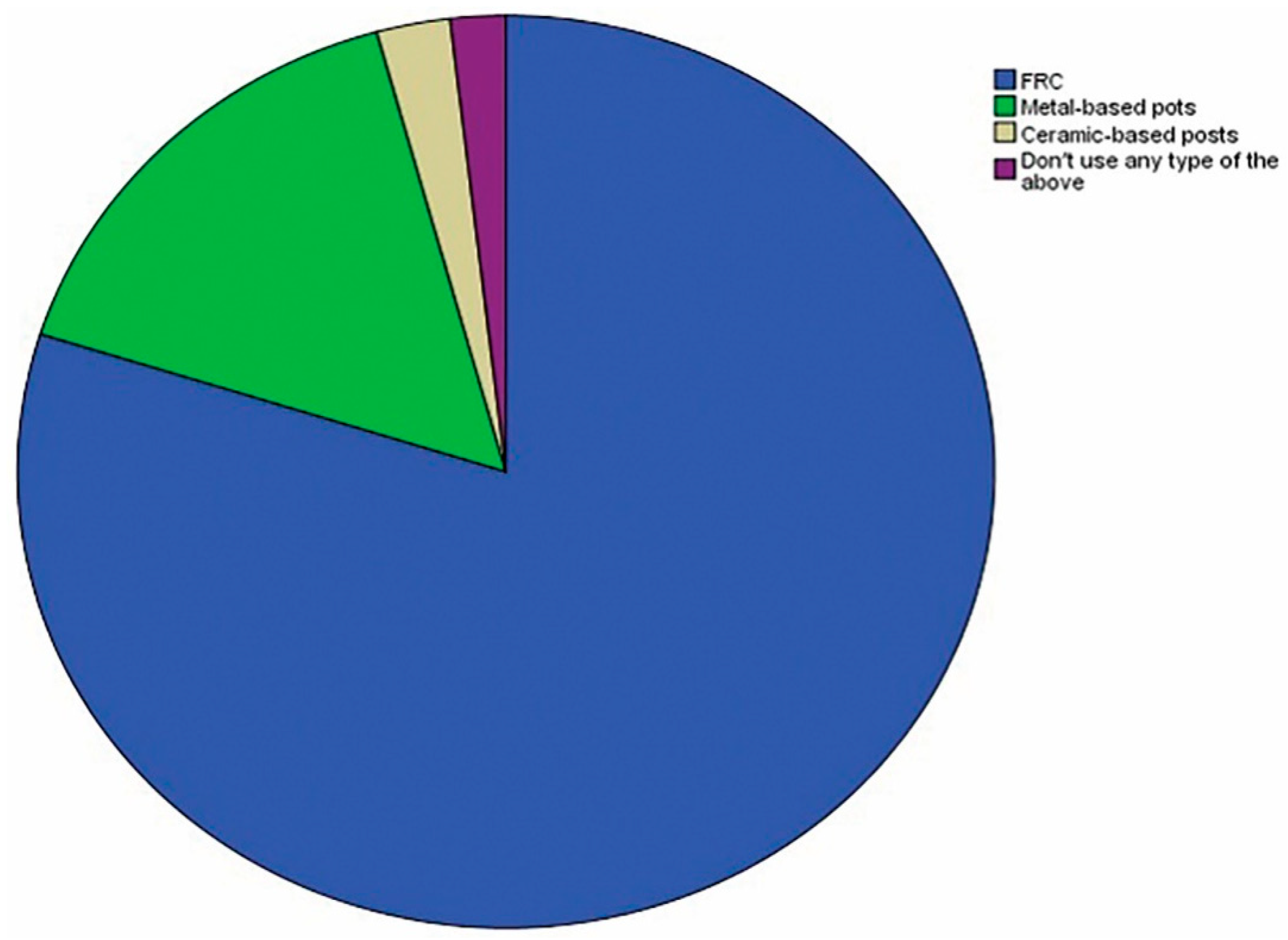Restoration Strategies of Endodontically Treated Teeth among Dental Practitioners in Saudi Arabia. A Nationwide Pilot Survey
Abstract
:1. Introduction
2. Materials and Methods
2.1. Involvement of the Participants
2.2. Questionnaire
- 1. Do you use posts in the treatment of ETT? - Yes - No
- 2. Which type of posts do you usually use? - Prefabricated posts - Custom-made cast posts and cores - I do not use posts in the treatment of my patients.
- 3. Do you believe that every endodontically treated tooth (ETT) must receive a post? - Yes - No - I do not know.
- 4. Do you believe that a post reinforces an ETT and reduces the fracture probability? - Yes - No - I do not know.
- 5. Do you believe that creating a ferrule below the core foundation following post cementation increases fracture resistance? - Yes - No - I do not know.
- 6. In your opinion, what is the main criterion in choosing between prefabricated posts and custom-made posts? - The remaining tooth structure - Ease of use - A reduced number of visits - Ease of removal when a problem has occurred - Cost - Aesthetic purposes - Tooth location (anterior or posterior) - Canal width - Other.
- 7. If you use prefabricated posts, which type do you mostly use? - Fiber-reinforced composite posts (FRC) (glass fiber posts, carbon fiber, mixed) - Metal-based pots (screws, titanium posts, stainless steel) - Ceramic-based posts (zirconia posts) - I do not use any type of the above - Others.
- 8. When you use a prefabricated metal post, which design do you mostly prefer? - Parallel-sided - Tapered - Combined parallel-sided/tapered - Screw type - Split flexible posts - Threaded - I do not use prefabricated metal posts - Other.
- 9. Which type of custom-made post and core do you mostly use? - Gold cast – Base-metal alloy -Titanium - Zirconia - I do not use custom-made cast posts - Other.
- 10. What type of cement do you use for post cementation? - Dual polymerized adhesive resin cement - Chemically polymerized adhesive resin cement - Self-adhesive resin cement - Glass ionomer - Resin-modified glass ionomer cement - Zinc phosphate cement - Polycarboxylate cement - Other.
- 11. What type of core build-up material do you mostly prefer to use with prefabricated posts? -Resin composite - Glass ionomer build-up material - Amalgam - Other.
- 12. When do you usually insert the posts into the canal after obturation? - Directly 24 h after obturation - One week post obturation - After several weeks post obturation - Other.
- 13. Should the tooth (with post and core) be crowned? - Yes - No - I do not know.
- 14. Which crown material do you usually indicate? - Full metallic crown - Full ceramics – Porcelain-fused-to-metal (PFM) - Other.
2.3. Statistics
3. Results
Demographic and General Information
- 1.
- Frequency of Use of Dental Posts in ETT
- 2.
- Type of Posts
- 3.
- Belief That Every ETT Must Receive a Post
- 4.
- Belief That Posts Strengthen ETT
- 5.
- The Importance of a Ferrule below the Core Foundation
- 6.
- The Main Criterion in Choosing between Fiber Posts and Custom-Made Posts? (Which Decision Criteria Led to the Preferred Use of Fiber Posts or Custom-Made Posts and Core System?)
- 7.
- Type of Prefabricated Posts
- 8.
- Design of Prefabricated Metal Posts
- 9.
- Type of Custom-Made Post and Core
- 10.
- Type of Cement Used for Post Cementation
- 11.
- Type of Core Build-Up Material Most Commonly Used with Prefabricated Posts
- 12.
- Time of Post Insertion
- 13.
- Should the Tooth (with Post and Core) Be Crowned?
- 14.
- Crown Material Used over ETT with Post and Core
4. Discussion
5. Conclusions
- -
- Most of the participants in the present study did not consider that ETT should receive a post. However, most of them believed that ETT should be crowned, and all-ceramic crowns were the preferred choice.
- -
- The majority of the surveyed dentists stated that the presence of a post could reinforce ETT.
- -
- The decision to utilize any type of post was mainly based on the remaining tooth structure.
- -
- Most of the participants believed that the presence of a ferrule would increase the fracture resistance of ETT.
Author Contributions
Funding
Conflicts of Interest
References
- Maroulakos, G.; Nagy, W.W.; Kontogiorgos, E.D. Fracture resistance of compromised endodontically treated teeth restored with bonded post and cores: An in vitro study. J. Prosthet. Dent. 2015, 114, 390–397. [Google Scholar] [CrossRef] [PubMed] [Green Version]
- Khurshid, Z.; Zafar, M.; Qasim, S.; Shahab, S.; Naseem, M.; AbuReqaiba, A. Advances in nanotechnology for restorative dentistry. Materials 2015, 8, 717–731. [Google Scholar] [CrossRef] [PubMed]
- Samran, A.; El Bahra, S.; Kern, M. The influence of substance loss and ferrule height on the fracture resistance of endodontically treated premolars. An in vitro study. Dent. Mater. 2013, 29, 1280–1286. [Google Scholar] [CrossRef] [PubMed]
- Mangold, J.T.; Kern, M. Influence of glass-fiber posts on the fracture resistance and failure pattern of endodontically treated premolars with varying substance loss: An in vitro study. J. Prosthet. Dent. 2011, 105, 387–393. [Google Scholar] [CrossRef]
- Abduljawad, M.; Samran, A.; Kadour, J.; Al-Afandi, M.; Ghazal, M.; Kern, M. Effect of fiber posts on the fracture resistance of endodontically treated anterior teeth with cervical cavities: An in vitro study. J. Prosthet. Dent. 2016, 116, 80–84. [Google Scholar] [CrossRef] [PubMed]
- Karzoun, W.; Abdulkarim, A.; Samran, A.; Kern, M. Fracture strength of endodontically treated maxillary premolars supported by a horizontal glass fiber post: An in vitro study. J. Endod. 2015, 41, 907–912. [Google Scholar] [CrossRef] [PubMed]
- Samran, A.; Al-Afandi, M.; Kadour, J.-A.; Kern, M. Effect of ferrule location on the fracture resistance of crowned mandibular premolars: An in vitro study. J. Prosthet. Dent. 2015, 114, 86–91. [Google Scholar] [CrossRef] [PubMed]
- Cheung, W. A review of the management of endodontically treated teeth. J. Am. Dent. Assoc. 2005, 136, 611–619. [Google Scholar] [CrossRef] [PubMed]
- Gu, X.-H.; Kern, M. Fracture resistance of crowned incisors with different post systems and luting agents. J. Oral Rehabil. 2006, 33, 918–923. [Google Scholar] [CrossRef] [PubMed]
- Butz, F.; Lennon, A.M.; Heydecke, G.; Strub, J.R. Survival rate and fracture strength of endodontically treated maxillary incisors with moderate defects restored with different post-and-core systems: An in vitro study. Int. J. Prosthodont. 2001, 14, 58–64. [Google Scholar] [CrossRef] [PubMed]
- Hemmings, K.W.; King, P.A.; Setchell, D.J. Resistance to torsional forces of various post and core designs. J. Prosthet. Dent. 1991, 66, 325–329. [Google Scholar] [CrossRef]
- Stavropoulou, A.F.; Koidis, P.T. A systematic review of single crowns on endodontically treated teeth. J. Dent. 2007, 35, 761–767. [Google Scholar] [CrossRef] [PubMed]
- Freedman, G.A. Esthetic post-and-core treatment. Dent. Clin. N. Am. 2001, 45, 103–116. [Google Scholar] [PubMed]
- Fredriksson, M.; Astbäck, J.; Pamenius, M.; Arvidson, K. A retrospective study of 236 patients with teeth restored by carbon fiber-reinforced epoxy resin posts. J. Prosthet. Dent. 1998, 80, 151–157. [Google Scholar] [CrossRef]
- Sorensen, J.A.; Martinoff, J.T. Intracoronal reinforcement and coronal coverage: A study of endodontically treated teeth. J. Prosthet. Dent. 1984, 51, 780–784. [Google Scholar] [CrossRef]
- Sagsen, B.; Aslan, B. Effect of bonded restorations on the fracture resistance of root filled teeth. Int. Endod. J. 2006, 39, 900–904. [Google Scholar] [CrossRef] [PubMed]
- Hussey, D.L.; Killough, S.A. A survey of general dental practitioners’ approach to the restoration of root-filled teeth. Int. Endod. J. 1995, 28, 91–94. [Google Scholar] [CrossRef] [PubMed]
- Eckerbom, M.; Magnusson, T. Restoring endodontically treated teeth: A survey of current opinions among board-certified prosthodontists and general dental practitioners in Sweden. Int. J. Prosthodont. 2001, 14, 245–249. [Google Scholar] [PubMed]
- Morgano, S.M.; Hashem, A.F.; Fotoohi, K.; Rose, L. Nationwide survey of contemporary philosophies and techniques of restoring endodontically treated teeth. J. Prosthet. Dent. 1994, 72, 259–267. [Google Scholar] [CrossRef]
- Kon, M.; Zitzmann, N.U.; Weiger, R.; Krastl, G. Postendodontic Resto-ration: A Survey Among Dentists in Switzerland. Schweiz. Monatsschr. Zahnmed. 2013, 123, 12–1076. [Google Scholar]
- Kavlekar, A.A. Treatment Concepts for Restoration of endodontically Treated Teeth: A Survey among General Practitioners, Prosthodontists, and Endodontists in India. J. Contemp. Dent. 2016, 6, 129–136. [Google Scholar] [CrossRef]
- Jacinkeviciute, L.; Gabseviciute, D.; Skirbutis, G. Knowledge and Practice of Restoring Endodontically Treated Teeth by Dentists in Panevezys. Int. Ann. Med. 2017, 1. [Google Scholar] [CrossRef] [Green Version]
- Naumann, M.; Kiessling, S.; Seemann, R. Treatment concepts for restoration of endodontically treated teeth: A nationwide survey of dentists in Germany. J. Prosthet. Dent. 2006, 96, 332–338. [Google Scholar] [CrossRef] [PubMed]
- Rabi, T.; Rabi, T.H. Attitudes of Palestinian Dentists toward Restoration of Endodontically Treated Teeth. Int. J. Prosthodont. Restor. Dent. 2015, 5, 44–50. [Google Scholar] [CrossRef]
- Naumann, M.; Neuhaus, K.W.; Kölpin, M.; Seemann, R. Why, when, and how general practitioners restore endodontically treated teeth: A representative survey in Germany. Clin. Oral Investig. 2016, 20, 253–259. [Google Scholar] [CrossRef] [PubMed]
- Hagge, M.S.; Wong, R.D.M.; Lindemuth, J.S. Retention strengths of five luting cements on prefabricated dowels after root canal obturation with a zinc oxide/eugenol sealer: 1. Dowel space preparation/cementation at one week after obturation. J. Prosthodont. 2002, 11, 168–175. [Google Scholar] [CrossRef] [PubMed]
- Torres-Sánchez, C.; Montoya-Salazar, V.; Córdoba, P.; Vélez, C.; Guzmán-Duran, A.; Gutierrez-Pérez, J.-L.; Torres-Lagares, D. Fracture resistance of endodontically treated teeth restored with glass fiber reinforced posts and cast gold post and cores cemented with three cements. J. Prosthet. Dent. 2013, 110, 127–133. [Google Scholar] [CrossRef]
- Goerig, A.C.; Leonard, A.M. Management of the endodontically treated tooth. Part I: Concept for restorative designs. J. Prosthet. Dent. 1983, 49, 340–345. [Google Scholar] [CrossRef]
- Goodacre, C.J.; Spolnik, K.J. The Prosthodontic Management of Endodontically Treated Teeth: A Literature Review. Part I. Success and Failure Data, Treatment Concepts. J. Prosthodont. 1994, 3, 243–250. [Google Scholar] [CrossRef] [PubMed]
- Fernandes, A.S.; Dessai, G.S. Factors affecting the fracture resistance of post-core reconstructed teeth: A review. Int. J. Prosthodont. 2001, 14, 355–363. [Google Scholar] [PubMed]
- Akkayan, B.; Gülmez, T. Resistance to fracture of endodontically treated teeth restored with different post systems. J. Prosthet. Dent. 2002, 87, 431–437. [Google Scholar] [CrossRef] [PubMed]
- AL-Wahadni, A.M.; Hamdan, S.; Al-Omiri, M.; Hammad, M.M.; Hatamleh, M.M. Fracture resistance of teeth restored with different post systems: In vitro study. Oral Surg. Oral Med. Oral Pathol. Oral Radiol. Endodontol. 2008, 106, e77–e83. [Google Scholar] [CrossRef] [PubMed]
- Kivanç, B.H.; Görgül, G. Fracture resistance of teeth restored with different post systems using new-generation adhesives. J. Contemp. Dent. Pract. 2008, 9, 33–40. [Google Scholar] [PubMed]
- Creugers, N.H.J.; Mentink, A.G.B.; Käyser, A.F. An analysis of durability data on post and core restorations. J. Dent. 1993, 21, 281–284. [Google Scholar] [CrossRef]
- Eckerbom, M.; Magnusson, T.; Martinsson, T. Prevalence of apical periodontitis, crowned teeth and teeth with posts in a Swedish population. Dent. Traumatol. 1991, 7, 214–220. [Google Scholar] [CrossRef]
- Cohen, B.I.; Pagnillo, M.K.; Newman, I.; Musikant, B.L.; Deutsch, A.S. Retention of three endodontic posts cemented with five dental cements. J. Prosthet. Dent. 1998, 79, 520–525. [Google Scholar] [CrossRef]
- Panitiwat, P.; Salimee, P. Effect of different composite core materials on fracture resistance of endodontically treated teeth restored with FRC posts. J. Appl. Oral Sci. 2017, 25, 203–210. [Google Scholar] [CrossRef] [PubMed] [Green Version]
- Aleisa, K.; AL-Dwairi, Z.N.; Alsubait, S.A.; Morgano, S.M. Pull-out retentive strength of fiber posts cemented at different times in canals obturated with a eugenol-based sealer. J. Prosthet. Dent. 2016, 116, 85–90. [Google Scholar] [CrossRef] [PubMed]
- Guess, P.C.; Schultheis, S.; Bonfante, E.A.; Coelho, P.G.; Ferencz, J.L.; Silva, N.R.F.A. All-ceramic systems: Laboratory and clinical performance. Dent. Clin. N. Am. 2011, 55, 333–352. [Google Scholar] [CrossRef] [PubMed]




© 2018 by the authors. Licensee MDPI, Basel, Switzerland. This article is an open access article distributed under the terms and conditions of the Creative Commons Attribution (CC BY) license (http://creativecommons.org/licenses/by/4.0/).
Share and Cite
Alenzi, A.; Samran, A.; Samran, A.; Nassani, M.Z.; Naseem, M.; Khurshid, Z.; Özcan, M. Restoration Strategies of Endodontically Treated Teeth among Dental Practitioners in Saudi Arabia. A Nationwide Pilot Survey. Dent. J. 2018, 6, 44. https://0-doi-org.brum.beds.ac.uk/10.3390/dj6030044
Alenzi A, Samran A, Samran A, Nassani MZ, Naseem M, Khurshid Z, Özcan M. Restoration Strategies of Endodontically Treated Teeth among Dental Practitioners in Saudi Arabia. A Nationwide Pilot Survey. Dentistry Journal. 2018; 6(3):44. https://0-doi-org.brum.beds.ac.uk/10.3390/dj6030044
Chicago/Turabian StyleAlenzi, Abdulrahman, Abdulaziz Samran, Ahlam Samran, Mohammad Zakaria Nassani, Mustafa Naseem, Zohaib Khurshid, and Mutlu Özcan. 2018. "Restoration Strategies of Endodontically Treated Teeth among Dental Practitioners in Saudi Arabia. A Nationwide Pilot Survey" Dentistry Journal 6, no. 3: 44. https://0-doi-org.brum.beds.ac.uk/10.3390/dj6030044





